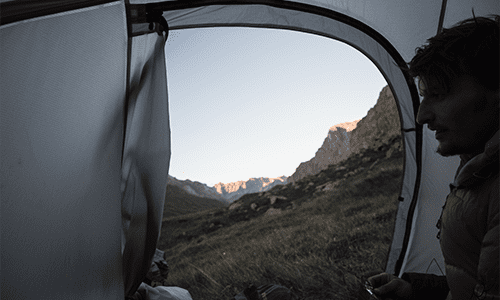

SAMAYA x JULIEN MAZARD
600 KM DE TRAVERSÉE ISLANDAISE EN GRAVEL

En août 2023, Julien Mazard et Loïc Doval sont partis réaliser une traversée de l’Islande en gravel, en autonomie. Le froid, le vent, les étapes longues et la complexité du parcours n’ont pas empêché le binôme de réaliser ce projet ardu. Julien nous raconte la diversité des paysages, les endroits sauvages parcourus, ainsi que la difficulté et la beauté de la traversée.
« L’idée était de réaliser une grande traversée à vélo, pas forcément extrême mais tout de même engagée. Avec Loïc, on cherchait des endroits sauvages au cœur de paysages uniques.
On était sur des chemins sur lesquels pendant des centaines de kilomètres, on ne traversait aucun village, on ne croisait personne. C’était à peine ponctué par quelques refuges.
On a fait quasiment 600 kilomètres, que du chemin nous faisant traverser des sites très sauvages, très lunaires, comme des espèces de déserts immenses. On a parcouru des paysages d’une grande variété, allant d’énormes plateaux encerclés de glaciers à des berges de rivière entourées de montagnes et de cascades.
Généralement, on faisait entre 50 et 100 kilomètres par jour en fonction de l'état des chemins et de la météo. Le plus dur dans ce genre d’expédition, ce n’est pas tant les distances à parcourir que les conditions météorologiques. Malgré le froid, on a eu la chance d’avoir le vent dans le dos et du soleil. Nous commencions nos journées vers 8h, en prenant le temps de nous réveiller et de prendre un bon petit déjeuner (le meilleur repas de la journée). Une fois la tente rangée, nous refaisions notre paquetage, qui n’était jamais le même que la veille, puis on commençait à rouler. 200 mètres plus tard, il y avait toujours un sac qui tombait. On serrait plus fort nos sangles et on repartait pour de bon.
Les kilomètres défilaient, ou pas ! On sait quand on part, mais jamais quand on arrive. Des rivières à traverser, du vent de face, des problèmes techniques, il se passait toujours quelque chose.
On avait prévu 9 jours d'autonomie. Au milieu du voyage, on a trouvé un refuge où il y avait des chips, des snickers et des bonbons. On était trop contents, on mangeait les trois en même temps. Le rapport à la nourriture avait un peu changé au cours du voyage. Notre chargement était très lourd, pour qu’on puisse être autonomes tout en pouvant manger beaucoup pour éviter le risque de fringale sur la route.
Toutes nos étapes ont une histoire particulière mais la toute première restera un souvenir spécial. Nous avions démarré d’Akureyri, une ville au nord de l'Islande, pour rejoindre Vik au sud, en 8 ou 9 jours maximum. Nous n’avions pas prévu plus de nourriture. Le jour du départ, on a décidé de modifier notre parcours. On se lançait dans quelque chose de trop difficile, avec des étapes où on aurait dû pousser les vélos sur des dizaines de kilomètres. Qui plus est, un volcan était apparemment prêt à entrer en éruption. Au cours de cette journée, on aura déjà vécu beaucoup de choses.
Le fait de partir en laissant la civilisation n’est pas si simple que ce que nous avions imaginé. On a effectué une longue traversée de tunnel et au bout de quelques kilomètres, nous nous sommes retrouvés avec des cascades immenses, de la pluie, du froid, du vent, du soleil, du chaud pour enfin arriver aux premiers kilomètres de piste et se diriger vers les Highlands, les hauts plateaux Islandais avec ses étendues sans limites.
Au fur et à mesure de notre progression, les paysages devenaient de plus en plus sauvages, les montagnes se dessinaient, les dernières maisons s’effaçaient pour laisser place à un énorme champ de lave à perte de vue. On est finalement arrivés à 23 heures à notre destination, un endroit hors du temps, au milieu du magma inerte depuis des milliers d'années. Nous étions déjà exténués après 8 heures de vélo et des semaines de préparation. La pression est redescendue, le sentiment de liberté s’est dégagé, l'aventure pouvait enfin commencer.


Nos journées ont été intenses. Particulièrement lorsque nous avons roulé pendant plusieurs jours à travers un désert sans fin, avec des pistes et des lignes droites à perte de vue. Un de ces jours, le temps s’est gâté. Il faisait très froid, le vent était glacial, les nuages nous tournaient autour, la pluie nous évitait. Quelques kilomètres avant notre arrivée, le soleil a enfin percé et le temps s’est dégagé pour faire apparaître un glacier au nom imprononçable, le plus grand d'Europe, puis un second plus à l'est.
Malgré notre habitude de voir des glaciers dans les Alpes, celui-ci était incomparable. Il s’étendait sur des centaines de kilomètres avec une calotte atteignant jusqu’à 1000 mètres par endroits. C’était un vrai choc de le voir pour la première fois.
Après une dernière rivière à traverser, on a finalement campé dans une plaine au milieu de ces 2 géants, le coucher de soleil étant sans fin à cette période de l'année. Le ciel était en feu. Nous étions pour notre part frigorifiés. Heureusement, nous avons pu nous mettre à l'intérieur de la tente et de nos duvets pour admirer ce spectacle unique. »


















